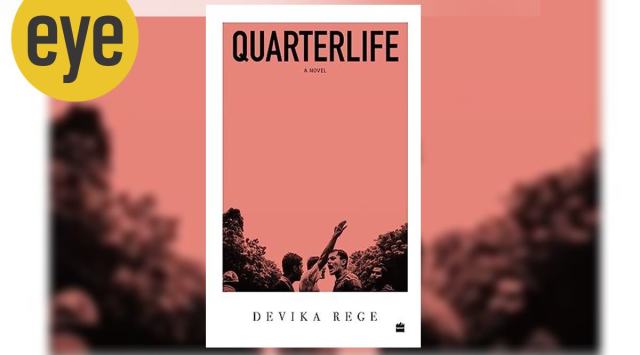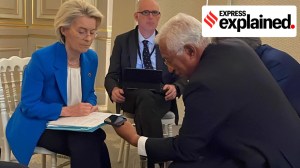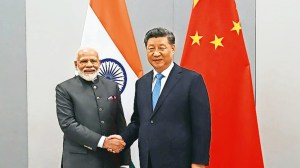A remarkable debut, Devika Rege’s Quarterlife forces us to ask questions of our present moment in history
Rege has a vast descriptive repertoire, is willing to take astonishing risks with structure, and is immaculate in her numerous interiority dives
 Tanuj Solanki
Quarterlife
Devika Rege
Fourth Estate
420 pages
Rs 599 (Pic source: Amazon)
Tanuj Solanki
Quarterlife
Devika Rege
Fourth Estate
420 pages
Rs 599 (Pic source: Amazon)What a novel says at its personal-political intersections must depend on when it was written, and clues might be available early. The first word in Anjum Hasan’s The Cosmopolitans, published in 2015 and presumably written during the UPA years, is ‘Nostalgia.’ Qayenaat, its 50-something protagonist, “the motherless girl who lived in a government bungalow and wanted so much to be an artist,” has to rebuild herself after recent mishaps while avoiding crushing nostalgia for her days of potential. The first word in Devika Rege’s debut novel Quarterlife, set in 2014-2015 and written during the Modi years, is ‘Anxiety.’ Its characters, in their 20s or 30s, are loaded with hypotheses about their, and the country’s, futures. Having potential has itself become a dangerous thing — what if it’s potential for bad?
Quarterlife starts with a simple scheme: one character’s perspective followed by another’s. We start with Naren in Waverly, Iowa, “losing his grip on who he is.” Naren’s maladjustment is no doubt because America offers no leeway for the animalistic in him: becoming an alpha during his consulting stint in Manhattan turned out to be impossible. Then we have Amanda at her house in rural New England, where restlessness (caused partly by her past-expiry boyfriend Andrei) makes her remember a time in childhood “when she insisted on straying past the windbreak to befriend the animals.” And finally, in Mumbai, we have Rohit, Naren’s younger brother, who runs a family-funded films-and-ads company with “no claimable talents” save a penchant for being “at the centre [of things].”
Naren and Amanda’s decisions to go to Mumbai coincide, and having once shared a sublet for a semester in UPenn, they travel on the same flight. Naren resumes consulting in Mumbai and finds that the right man’s coming-to-power has made the country suitable for his instincts. Amanda has a fellowship that has her working in the slums of Deonar, where she grapples with India’s caste-class-gender dynamics through a series of incidents. Rohit, meanwhile, grows enamoured with the potential of a rookie filmmaker named Omkar. He and Amanda also get into a situationship.
The novel’s scope formally widens around its middle, when it takes up the task, implicit in the title, of speaking for a generation. This happens in a stupendous chapter titled Friends, Brothers, Lovers, surely one of the best dramatic sequences this reader has ever read. In it, the narrative point-of-view flits, para by para, between nine characters, as a long conversation about the state of the nation progresses with increasing rancour. Coordinates on the axes of caste, class, sexuality, and gender are the sources of each person’s viewpoint, but Rege knows that only the deeply personal determines how intensely we communicate or suppress our politics. The chapter ends with a bang and the perspectival range opens up to follow nine characters instead of three.
It must be said, though, that any effort to turn demography into dramaturgy faces a question of limits. Are these many characters adequate? Are these identities representative enough? In the novel’s denouement on a Ganpati visarjan night, Rege takes the para-length-PoV mode of Friends, Brothers, Lovers further. Nine characters become 27 (maybe more; we even get a dog’s perspective at one point) as a riot unfolds in parts of Mumbai. The kaleidoscopic treatment is taken to such an extreme that if not grasped with the right energy, one may begin to see haphazardness where there is design. Moreover, a novel, which was until now invested in interiorities and gradually expanding drama, may appear to be staking too much of its final act on an external event, a deus ex machina.
The about-the-Modi-era Indian political novel is set to become a genre, and the genre is likely to be more about dire actuality than about soured potentiality. Asking why a novel of this genre, published in 2023, doesn’t arrive at demonetisation, surgical strikes, CAA-NRC, or the farmers’ protest is valid. How would Naren have justified these? What changes would Rohit have gone through during these events? Would Gyaan have joined the protests in Delhi?
But these questions have a tad of the wishful about them, in that they demand of the form of the novel an expansiveness that it is under no obligation to provide. Likewise, to read Quarterlife’s final act as haphazard is to miss its zeitgeist-seeking nature. We have in it a novel aiming to trace the psychologies of the young in the first year of Modi’s India. Can a novel like this exclude the possibility of an overwhelming external event? Hasn’t this country’s quarter-life crisis been one in which a faceless, motivated mob is an ever-present character?
Quarterlife forces us to ask such questions of the current era and of Indian story-telling in the current era. To this reader, it is as much a landmark novel as The Cosmopolitans is. Rege has a vast descriptive repertoire, is willing to take astonishing risks with structure, and is immaculate in her numerous interiority dives. Her hand is so sure that it’s often impossible to believe that Quarterlife is a debut.
Tanuj Solanki is an award-winning fiction writer. His last novel is Manjhi’s Mayhem (2022)
📣 For more lifestyle news, follow us on Instagram | Twitter | Facebook and don’t miss out on the latest updates!
Photos





- 01
- 02
- 03
- 04
- 05

























